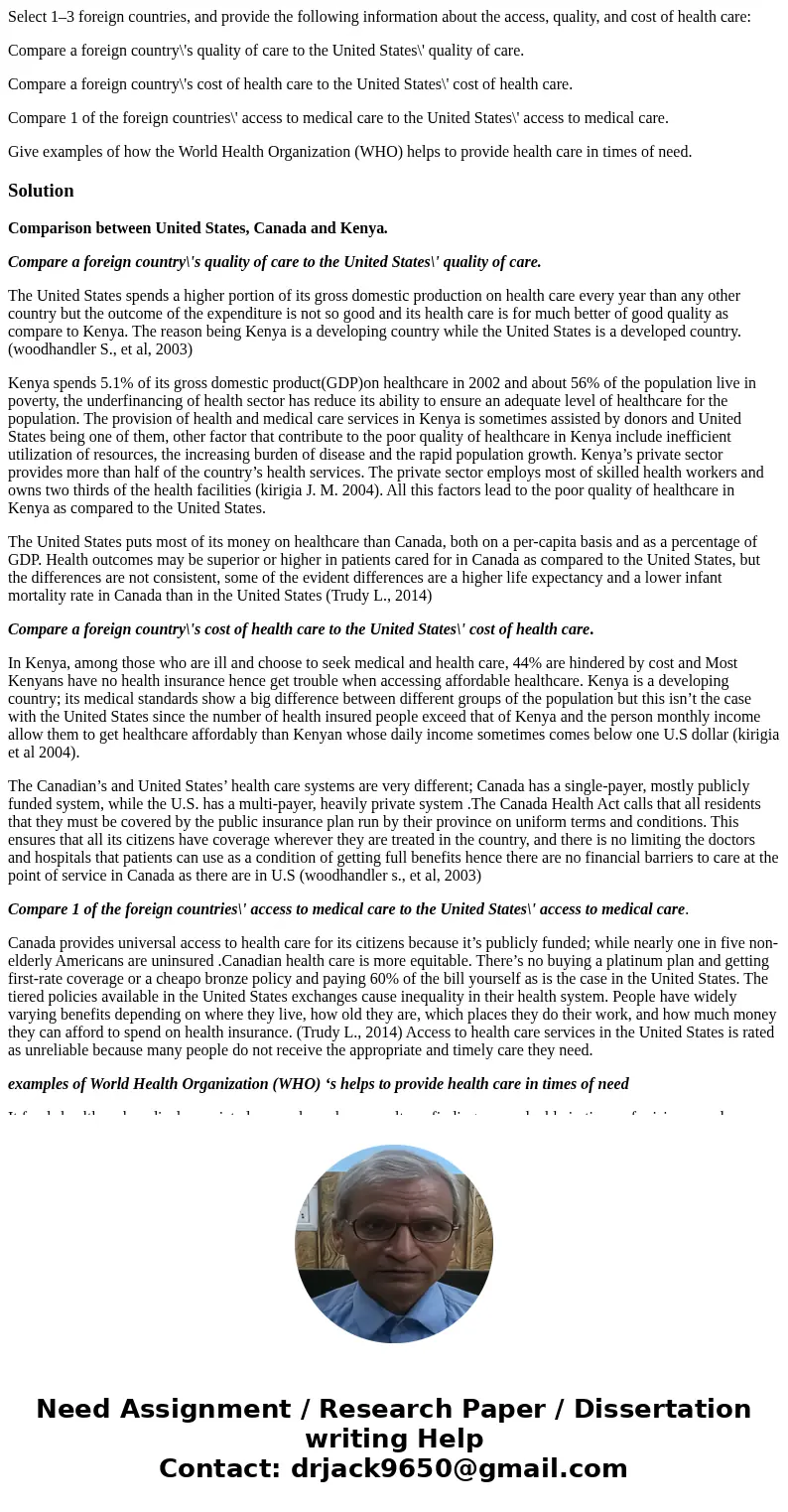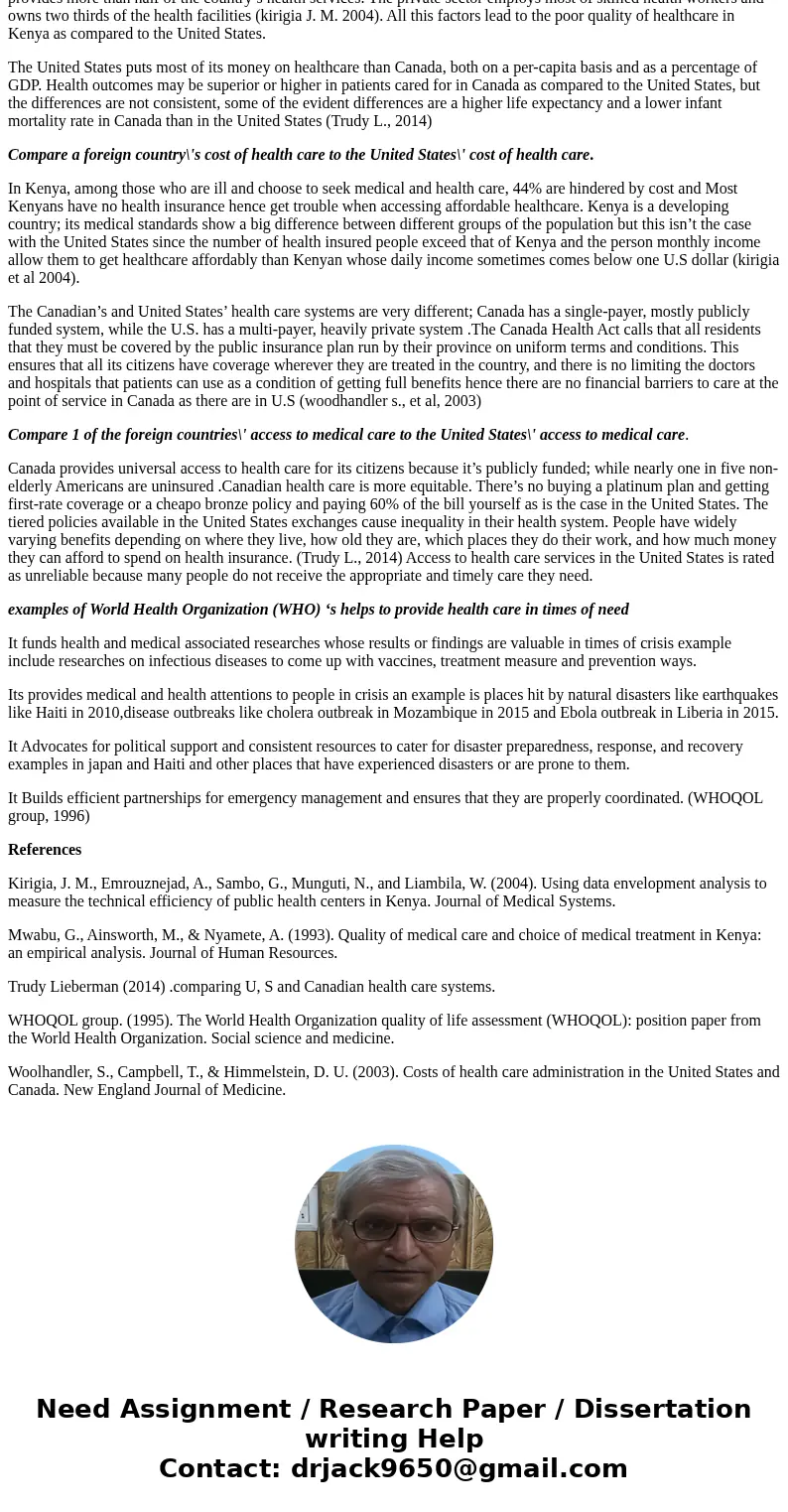Select 13 foreign countries and provide the following inform
Select 1–3 foreign countries, and provide the following information about the access, quality, and cost of health care:
Compare a foreign country\'s quality of care to the United States\' quality of care.
Compare a foreign country\'s cost of health care to the United States\' cost of health care.
Compare 1 of the foreign countries\' access to medical care to the United States\' access to medical care.
Give examples of how the World Health Organization (WHO) helps to provide health care in times of need.
Solution
Comparison between United States, Canada and Kenya.
Compare a foreign country\'s quality of care to the United States\' quality of care.
The United States spends a higher portion of its gross domestic production on health care every year than any other country but the outcome of the expenditure is not so good and its health care is for much better of good quality as compare to Kenya. The reason being Kenya is a developing country while the United States is a developed country. (woodhandler S., et al, 2003)
Kenya spends 5.1% of its gross domestic product(GDP)on healthcare in 2002 and about 56% of the population live in poverty, the underfinancing of health sector has reduce its ability to ensure an adequate level of healthcare for the population. The provision of health and medical care services in Kenya is sometimes assisted by donors and United States being one of them, other factor that contribute to the poor quality of healthcare in Kenya include inefficient utilization of resources, the increasing burden of disease and the rapid population growth. Kenya’s private sector provides more than half of the country’s health services. The private sector employs most of skilled health workers and owns two thirds of the health facilities (kirigia J. M. 2004). All this factors lead to the poor quality of healthcare in Kenya as compared to the United States.
The United States puts most of its money on healthcare than Canada, both on a per-capita basis and as a percentage of GDP. Health outcomes may be superior or higher in patients cared for in Canada as compared to the United States, but the differences are not consistent, some of the evident differences are a higher life expectancy and a lower infant mortality rate in Canada than in the United States (Trudy L., 2014)
Compare a foreign country\'s cost of health care to the United States\' cost of health care.
In Kenya, among those who are ill and choose to seek medical and health care, 44% are hindered by cost and Most Kenyans have no health insurance hence get trouble when accessing affordable healthcare. Kenya is a developing country; its medical standards show a big difference between different groups of the population but this isn’t the case with the United States since the number of health insured people exceed that of Kenya and the person monthly income allow them to get healthcare affordably than Kenyan whose daily income sometimes comes below one U.S dollar (kirigia et al 2004).
The Canadian’s and United States’ health care systems are very different; Canada has a single-payer, mostly publicly funded system, while the U.S. has a multi-payer, heavily private system .The Canada Health Act calls that all residents that they must be covered by the public insurance plan run by their province on uniform terms and conditions. This ensures that all its citizens have coverage wherever they are treated in the country, and there is no limiting the doctors and hospitals that patients can use as a condition of getting full benefits hence there are no financial barriers to care at the point of service in Canada as there are in U.S (woodhandler s., et al, 2003)
Compare 1 of the foreign countries\' access to medical care to the United States\' access to medical care.
Canada provides universal access to health care for its citizens because it’s publicly funded; while nearly one in five non-elderly Americans are uninsured .Canadian health care is more equitable. There’s no buying a platinum plan and getting first-rate coverage or a cheapo bronze policy and paying 60% of the bill yourself as is the case in the United States. The tiered policies available in the United States exchanges cause inequality in their health system. People have widely varying benefits depending on where they live, how old they are, which places they do their work, and how much money they can afford to spend on health insurance. (Trudy L., 2014) Access to health care services in the United States is rated as unreliable because many people do not receive the appropriate and timely care they need.
examples of World Health Organization (WHO) ‘s helps to provide health care in times of need
It funds health and medical associated researches whose results or findings are valuable in times of crisis example include researches on infectious diseases to come up with vaccines, treatment measure and prevention ways.
Its provides medical and health attentions to people in crisis an example is places hit by natural disasters like earthquakes like Haiti in 2010,disease outbreaks like cholera outbreak in Mozambique in 2015 and Ebola outbreak in Liberia in 2015.
It Advocates for political support and consistent resources to cater for disaster preparedness, response, and recovery examples in japan and Haiti and other places that have experienced disasters or are prone to them.
It Builds efficient partnerships for emergency management and ensures that they are properly coordinated. (WHOQOL group, 1996)
References
Kirigia, J. M., Emrouznejad, A., Sambo, G., Munguti, N., and Liambila, W. (2004). Using data envelopment analysis to measure the technical efficiency of public health centers in Kenya. Journal of Medical Systems.
Mwabu, G., Ainsworth, M., & Nyamete, A. (1993). Quality of medical care and choice of medical treatment in Kenya: an empirical analysis. Journal of Human Resources.
Trudy Lieberman (2014) .comparing U, S and Canadian health care systems.
WHOQOL group. (1995). The World Health Organization quality of life assessment (WHOQOL): position paper from the World Health Organization. Social science and medicine.
Woolhandler, S., Campbell, T., & Himmelstein, D. U. (2003). Costs of health care administration in the United States and Canada. New England Journal of Medicine.


 Homework Sourse
Homework Sourse